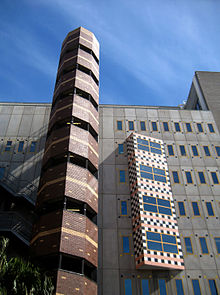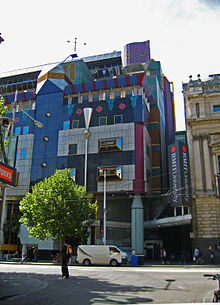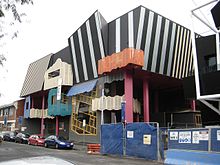- Edmond and Corrigan
-
Edmond and Corrigan is an Architectural firm based in Melbourne, Australia, founded in the late 1970s by partners Maggie Edmond and Peter Corrigan, who remain the firm's principals. The practice's work, both built and written, has been widely associated with the emergence of architectural postmodernism in Australia,[1] an interest in suburbia [2] and a search for an Australian architectural identity.[3] Peter Corrigan is also known for having taught design studios at RMIT University for over 30 years.
Contents
Early life and studies
Born into a Catholic family, Peter Corrigan first studied commerce for two years before he decided to pursue architecture, enrolling at the University of Melbourne in 1961. Corrigan's student work attracted the attention of his teachers for being unique, complex and contradictory,[4] and began to play out many of the concerns which came to characterise the practice's body of work. A foreshadowing of the practice's engagement with symbolism is also apparent in a 1961 letter to the University of Melbourne's Farrago student newspaper, defending Roy Ground's design for the Victorian College of the Arts against the contemporary tide of functionalist critique and arguing for the value of expression in public buildings.[5]
He obtained his Bachelor of Architecture in 1966 from the University of Melbourne, though his relationship with the school's Architecture department was uneasy [6] and he was required to repeat his final year there. In 1967, however, he received a scholarship from Yale university and travelled to the United States, driven by an interest in the American theatre and the volatile architectural climate.[7]
Maggie Edmond had decided on architecture relatively early and progressed more smoothly through Architecture school, obtaining her degree three years after Corrigan in 1969 and winning several awards for general excellence during her studies.[8] During their studies, doth Edmond and Corrigan were engaged in different groups within the Melbourne theatre community and specifically in theatrical set design.
Architectural practice
Before returning to Australia, Corrigan worked in various large architectural practices in the United States, alongside work for the theatre and tutoring at Yale. After working briefly with the New Haven Redevelopment agency as a senior urban planner, he became a design architect at the firm of Roche-Dinkeloo, which had been the office of Eero Saarinen, where he worked from 1969–1971. He then moved to New York to work with Paul Rudolph, who had been an influence on Corrigan during his time as the dean of Yale's architecture school. Subsequent work in the United States included time under César Pelli and Phillip Johnson.
During much of this time, Edmond was working on large-scale projects in Melbourne and Sydney, including the Hyatt Hotel at Kings Cross, and several stadiums and office buildings with firm Meldrum Burrows. In 1973 she began working in the newly established conservation office of architectural firm Yuncken Freeman, and extensively documented and drew historic buildings and streetscapes throughout Melbourne. During this time, Edmond was also active in community-based campaigns against demolition and for conservation outside of her role at Yuncken-Freeman.
The practice of Edmond and Corrigan was officially formed in 1975, though the pair had gradually been collaborating and associating on projects after Corrigan's return from America in 1974. Much of their early work consisted of church buildings and community buildings for the Catholic communities of suburban Melbourne.
The Keysborough Church of the Resurrection, completed in 1977, and later buildings in Keysborough, are considered key projects in establishing the practice's approach and architectural language.[9] Critics have identified an affinity in this project with American architectural pluralism and with the period's reform of church design, Cities of Hope, p54</ref> but also an interpretation of Australian Federation architecture, Structural Expressionism, and references to rural and suburban vernacular architecture. The project was published in 1977 and became a pivotal part of the contemporary debate between the prevalent regional architectural modernism and an emerging architectural post-modernism.[10]
The practice's subsequent projects – many of them in suburban sites, rather than the prevailing architectural arenas of rural houses and urban buildings – continued to engage the idea of an Australian architectural language, visible in their competition entries for the Parliament House, Canberra Competition in 1977, The Australian Stockman's Hall of Fame and the State Library of Victoria, their many projects for community buildings, and their work for universities.
The practice's success and controversy during these years allowed them to undertake larger scaled projects. Many of their larger projects, particularly RMIT's Building 8, pursued the idea of 'a city in a single building'.[11] Their Athan House of 1986 was published widely and brought the practice to international attention.
They also worked extensively in stage and set design for Opera Australia, Melbourne University Theatre Group, and La Mama.
Notable Projects and Awards
- Athan House, Monbulk, Vic., 1986–88
- RAIA Vic. Chapter Bronze Medal for Outstanding Architecture Award,
- New Residential Category, 1989
- Walsh House, Scheme for Pool Pavilion, 1993–94
- Architecture Australia Prize for Unbuilt Work, 1994
- Royal Melbourne Institute of Technology
- Building 8 Extension, RMIT University, Melbourne, Vic., 1990–94
- RAIA Vic. Chapter Architecture Medal, 1995
- City of Melbourne Building and Planning Award, Institutional Buildings Category, 1995
- RAIA Vic. Chapter Institutional Alterations and Extensions Award, 1995
- RAIA Walter Burley Griffin National Award for Urban Design, 1995
- Windsor Fire Station, Windsor, Vic., 1993–96
- Metal Building Award, Certificate of Merit, 1996
- RAIA Vic. Chapter Award of Merit, BHP Colorbond Steel Award, 1997
- RAIA Vic. Chapter Award of Merit, Commercial Category, 1997
- Ringwood Library Complex, Civic Plaza, Ringwood, Vic., 1994–95
- RAIA Vic. Chapter Urban Design Award, 1995
- RAIA Vic. Chapter Award of Merit, Institutional Category, 1996
- Stage I, Exhibition Centre Showgrounds, Ascot Vale, Vic., 1996
- RAIA Vic. Chapter Award of Merit, Commercial Category, 1997
- Niagara Galleries, Richmond, Vic., 2001.
- Dulux Colour Awards, Commercial Exterior Winner, 2002
- R.A.I.A. Vic. Chapter BHP Colorbond Award, 2002
In 2003 Peter Corrigan was awarded the RAIA Gold Medal, 2003, the highest accolade of the Australian architecture profession. In 1993 he was awarded an Honorary Doctorate in Architecture from RMIT University.
Academic and educational work
Peter Corrigan has been described as "the engine of postmodern architectural change in Australian architecture" [1] and is widely recognised for his writing both about his own practice's work and about others, wherein he makes explicit the practice's goal of creating or fostering a particularly Australian architectural language. He was, alongside Robin Boyd, active in maintaining the architectural journal Smudges during his time at The University of Melbourne. In the early seventies and with Ian McDougall, he was also a key figure in the initiation of the architectural magazine Transitions, which became a hugely influential publication in Australian architecture.[3] He was also a central participant in the notorious 'Half-Time Club', a boisterous regular meeting of architectural practitioners and critics in Melbourne that continued into the 1990s.
He is also widely known for his design studio at RMIT, which has been running for over 30 years, and for his extensive library of rare architectural books. Maggie Edmond continues to work with Deakin University in both an administrative and architectural and planning capacity.
References
- ^ a b Doug Evans, The Changing of the Guard: the social and cultural reflections of Community in 1970s Melbourne architecture, Fabrications, Vol 15, No 1, July 2005, p39
- ^ Conrad Hamann, Cities of hope: Australian architecture and design by Edmond and Corrigan, 1962-1992, Oxford University Press, 1993
- ^ a b Norman Day, 'Doing it his way', The Age, 1 September 2003.
- ^ Conrad Hamann, 'Celebrating Peter Corrigan', Architecture Australia March/April 2003, see http://www.architecturemedia.com/aa/aaissue.php?issueid=200303&article=9&typeon=2
- ^ Hamann, Cities of Hope, p7
- ^ Hamann, Cities of Hope, p15
- ^ Hamann, Cities of Hope, p25
- ^ Hamann, Cities of Hope, p34
- ^ Hamann, Cities of Hope, p51
- ^ Evans, p41
- ^ Hamann, Cities of Hope, p129
External links
Categories:- Architecture firms of Australia
- University of Melbourne alumni
- RMIT University faculty
- Architecture firms based in Victoria (Australia)
Wikimedia Foundation. 2010.



